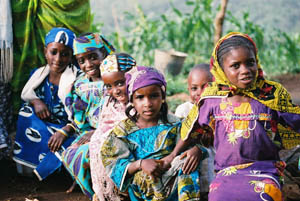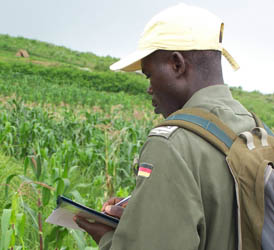CONSERVATION THROUGH RESEARCH:
GENERATING KNOWLEDGE
Feeding Ecology of Baboons: A Recipe for Success
Gashaka baboons are unusual as they not only thrive in open woodland savannah but also in rather thick forest. This natural experiment is interesting because a similar flexibility exhibited by early humans might have been the recipe for our species' enormous success.


Reproductive Endocrinology: What it Takes to Become Pregnant
Hormonal profiles can be reconstructed from analyses of female dung samples. Researchers may thus understand how different diets such as purely “natural” food versus a menu supplemented by crop-raiding influences primate pregnancy rates.


Seed Dispersal: How Forests Rejuvenate
Many trees depend on fruit-eaters to spread their seeds. Primary dispersers include birds, bats and primates. Secondary dispersers such as dung-beetles fragment dung deposits, thus creating favourable conditions for germination. The role of seed-dispersers in the maintenance of Nigerian forests has not previously been studied.


Baboon Banter: What's in a Bark?
Primates often use auditory signals to communicate with each other. Recipients are expected to tailor their reaction in response to characteristics of these signals by, for example, assessing their quality and thus reliability. Given the multitude of grunts, barks and calls, baboon groups are ideal to study the interplay between senders and recipients of auditory signals.


Guenon Calls: Roots of Communication & Cognition
Experiments with models of predators such as crowned eagles and played-back calls of leopards elicit alarm calls in Mona monkeys and Putty-nosed guenons. It is not known if such calls simply reflect the fearful emotions of these arboreal monkeys or if some sort of grammar is encoded in the call sequences. Such research helps to understand how human language evolved.


Chimpanzee Feeding Ecology: The Cause of Sociality?
Chimpanzees are rather aggressive "patriarchal" apes. Their close relatives, the bonobos, live in "matriarchal" societies where females are the powerbrokers. Bonobos are perhaps relatively relaxed because their rainforest home might yield food of higher quality. This hypothesis is tested by comparing the macro-nutrients and anti-feedants in fruits collected in Nigeria with ape food from the Congo region.


Cultural Primatology: Subsistence Technology of Chimpanzees
Chimpanzees across Africa employ varying tool-kits to harvest insect prey, honey or nuts. Whether differences between ape populations are due to different environments or reflect "cultural variants" may help us explain how the enormous behavioural diversity found amongst humans developed.


Pan troglodytes vellerosus: Distribution & Extinction Risk
Six sanctuaries in Nigeria and Cameroon currently hold infant apes ("bushmeat orphans"). Close to 4,000 wild chimpanzees of the rarest subspecies must have been killed over the last decade to produce these intake-rates. The subspecies will be extinct in less than 20 years, if this trend continues. Our extensive ground-surveys, unfortunately, confirm this bleak outlook, as even those remote forests that are not yet destroyed are often "hunted empty". Gashaka is still a big exception.


A Conservation Experiment: Political Ecology of the Highland Enclaves
Settled Fulani pastoralists were not evicted when the National Park was created. Instead, farmers and cattle-herders were envisioned to protect and assist in the management of their enclaves and surrounding parkland. The Fulani's attitudes, secular and spiritual beliefs are studied with respect to conflicts such as with crop-raiding wildlife and encroachment.


Environmental Dynamics: Reconstructing & Monitoring an Ancient Landscape
Humans have exploited the resources of what is now a National Park for centuries. The region's past and current plant cover can be reconstructed combining archaeobotanical records, floristic surveys and remote sensing imagery - a powerful and necessary tool to monitor and manage Gashaka's vast wilderness.


